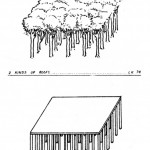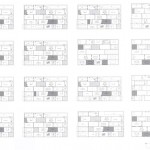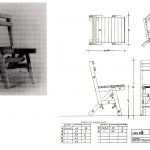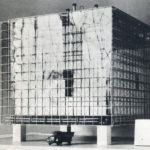In 1974, American artist Sol LeWitt created one of his major works, a seminal piece on the themes of seriality and variation, the series entitled “Variations of Incomplete Open Cubes”. The work is a collection of 122 frame structures presented together with the corresponding diagrams arranged on a matrix. Each sculpture is the projection of a three-dimensional cube with some of the edges removed in a way that the structure stays three-dimensional and the edges stay all connected. The minimum number of edges kept is three and the maximum is eleven. The viewer is able to mentally reconstruct the complete form of the cube from the remaining parts.
Given the rules, the exercise starts from the simple question: “how many variations can be created by systematically subtracting parts from an open cube?” LeWitt took the basic and universal known form of the cube and starts to analyze and disembody it, depriving the work of art of any subjective judgment and artistic researches involving composition or expression in order to make the work respond purely to an idea, following his famous 1967 statement “The idea becomes a machine that makes the art”.
The work was carried out by the artist through a long process which involved different media: at first, the cubes were sketched and labelled alphabetically and numerically. He then made models for each one of them and made sure no configuration was repeated once the structure is rotated, the cubes were then built in painted wood and in aluminium.
My own work of the past ten years is about only one thing, logical statements using formal elements as grammar. Sol LeWitt
A video by SF Moma on the Art Work: Sol LeWitt and curator Gary Garrels discuss LeWitt’s installation Incomplete Open Cubes (1974)
Art critic and theorist Rosalind Krauss (already quoted on Socks) wrote a career-defining essay on Sol Lewitt (Rosalind E. Krauss, “LeWitt in Progress,” The Originality of the Avant-Garde and Other Modernist Myths (Cambridge and London: MIT Press, 1985): 244-258, see the link at the ed of the post), underlining the obsessive and irrational character of thje artist’s work. Here’s an excerpt:
Like most of LeWitt’s work, Variations of Incomplete Open Cubes [1974] provides one with an experience that is obsessional in kind. On the vast platform, too splayed to be taken in at a glance, the 122 neat little fragmented frames, all meticulously painted white, sit in regimented but meaningless lines, the demonstration of a kind of mad obstinacy… [U]nlike the algebraic expression of the expansion of a given series, where the formulaic is used precisely to foreclose the working out of every term in the series, LeWitt’s work insistently applies its generative principle in each of its possible cases… The babble of a LeWitt serial expansion has nothing of the economy of the mathematician’s language. It has the loquaciousness of the speech of children or of the very old, in that its refusal to summarize, to use the single example that would imply the whole, is like those feverish accounts of events composed of almost identical details, connected by “and.”
But it is not entirely like those examples. For garrulousness, babble, the spasmodic hiccup of repetitious detail, have about them a quality of randomness, disorganization… And LeWitt’s outpouring of example, his piling up of instance, is riddled with system, shot through with order. There is, in Variations of Incomplete Open Cubes, as they say, a method to his madness. For what we find is the “system” of compulsion, of the obsessional’s unwavering ritual, with its precision, its neatness, its finicky exactitutde, covering over an abyss of irrationality…
LeWitt spoke of it when he wrote, “Irrational thoughts should be followed absolutely and logically.” The consequence of following this direction, and LeWitt’s art does obey it, is to arrive at the opposite of Idealism…
To get inside the systems of this work…is precisely to enter a world without a center, a world of subsitutions and transpositions nowhere legitimated by the revelations of a transcendental subject… Aporia is a far more legitimate model for LeWitt’s art than Mind, if only because aporia is a dilemma rather than a thing.
Further reading:
From a mathematical point of view: “Analysis of Incomplete open cubes by Sol LeWitt” by Michael Allan Rebb
and:
Is the List of Incomplete Open Cubes Complete?
Rosalind E. Krauss, “LeWitt in Progress,” The Originality of the Avant-Garde and Other Modernist Myths (Cambridge and London: MIT Press, 1985): 244-258.






[…] […]